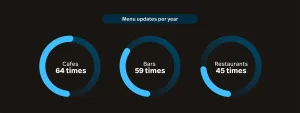
Menus don’t sit still for long these days. They can’t.
In a climate where costs keep shifting, ingredients swing in and out of reach and diners demand both novelty and value, keeping your menu frozen in time is a luxury few venues can afford.
Fortunately, most operators aren’t standing still either.
Lightspeed data shows that Australian venues are updating their menus an average of 53 times per year. That’s roughly once a week. And in the cafe segment, it jumps to 64 times annually—more than once a week, every week.
If that number feels high, it’s handy to keep in mind what “updating the menu” actually means.
According to the survey, a menu refresh includes anything from introducing new dishes and tweaking portion sizes to adding seasonal ingredients or changing presentation. It’s not about tearing everything down and starting from scratch—it’s about keeping things in motion.
But while menu changes are happening often, pricing strategies are starting to cool. After a wave of steep price hikes in 2023, 2024 saw a more measured, careful approach.
Let’s dig into what’s driving the shift.
- Most venues are changing menus weekly
- Bigger revenue doesn’t mean more changes
- Price hikes are slowing down
- Smart operators are updating without overwhelming
- What should you do next?
- Keep the wheel turning
Want more insights on the state of hospitality?
Lightspeed’s 2025 Hospitality Report reveals the shifts reshaping the guest experience. Explore the full report for free today.
Most venues are changing menus weekly
Let’s start with the big picture.
Across the board, hospitality businesses are refreshing their menus around once a week.
That includes everything from small ingredient swaps to introducing new seasonal items. And when you zoom in by venue type, things get even more interesting.
Cafes are leading the charge with an average of 64 updates per year. That’s no surprise. Cafes often run with tighter margins, smaller menus and more flexibility to trial changes. Swapping out a toast topping or rotating pastry suppliers can happen fast—and doesn’t require a full kitchen overhaul.
Bars follow at 59 updates per year, driven likely by seasonal cocktail lists, event menus and shifting customer tastes. Flexibility is baked into the model.
Restaurants, on the other hand, are more deliberate, averaging 45 updates annually. That slower pace likely reflects the complexity of restaurant operations—larger teams, multi-course menus and more moving parts that require coordination.
What all of this tells us is that frequent updates are the norm, but the way they show up varies dramatically by venue type.
Bigger revenue doesn’t mean more changes
Another key pattern emerging in the data is that high-revenue venues tend to update their menus less often than their lower-revenue peers.
Why?
Because complexity increases with scale. When your kitchen team is bigger, and your supply chains are more locked in and your brand is more established, even small changes can have a ripple effect. Menu updates start to require more planning, more coordination—and carry more risk if they go wrong.
That doesn’t mean these venues aren’t evolving—they are—but they’re just evolving at a more selective pace.
It also shows that constantly reinventing your menu isn’t a prerequisite for success. In fact, for some venues, pulling back can be a sign of confidence and stability.
Price hikes are slowing down
Now to the other side of the menu coin: pricing.
In 2023, venue operators were playing catch-up. Skyrocketing costs led to some steep increases across the board, with the national mean sitting at a 30% price rise.
Cafes and bars were hit hardest, with price jumps of 32% and 33% respectively. Restaurants landed a bit lower at 27%, likely due to already higher baseline pricing and more cautious, deliberate changes.
Fast forward and things look different.
The national mean price rise has fallen to 22%. It’s still a meaningful increase, but a significant cooldown from the year before. Across all venue types, there’s a shift away from aggressive pricing towards more incremental adjustments:

These shifts matter.
It suggests a maturing response from venues that they now understand the landscape better. They’re not overcorrecting; they’re adapting in stride.
Smart operators are updating without overwhelming
The question, of course, is how do you walk the line?
How do you keep menus fresh but not so changeable that your kitchen or front-of-house can’t keep up? You want to raise prices—but not so sharply that regulars start disappearing.
The data suggests that operators are starting to get this balance right. Frequent updates don’t have to mean constant reinvention. They can mean subtle shifts—changing a garnish, revising a portion, adding a seasonal twist or retiring a low performer.
It’s also worth remembering that menu changes don’t need to be visible to customers to be valuable. A lot of behind-the-scenes updates (like portion adjustments or supplier changes) can improve margins without altering the guest experience at all.
Pricing strategy follows the same logic.
Instead of one big, clunky increase each year, we’re seeing venues make smaller, smarter adjustments more often—especially in cafes and bars. These measured changes are easier for customers to digest and less likely to result in backlash.
What should you do next?
There’s no universal right answer, but the most successful operators are doing three things well:
- Tracking performance
They’re using data to identify which dishes are underperforming or dragging on margin. That gives them the confidence to act—without guessing. - Staying flexible
They’re not afraid to make regular, low-impact changes. A rotating sandwich. A seasonal pasta. A new entreé. It doesn’t have to be flashy—it just has to move. - Pacing their price rises
They’re adjusting prices in increments and tying them to tangible improvements in quality, presentation or portion size. Customers are far more likely to accept a 5% increase if they’re getting something that feels 10% better.
Keep the wheel turning
Menus are no longer static. In the modern hospitality landscape, they’re living documents—shaped by seasonality, customer trends and the evolving cost of doing business.
Whether you’re running a hatted restaurant or a takeaway espresso bar, the same tension applies: you’re trying to keep pace with costs without losing your footing with customers.
The good news? You’re not alone. Most venues are updating every week and price hikes have settled. And across the board, operators are finding smarter, calmer ways to stay profitable without burning out.
So if you’ve been second-guessing your next menu refresh—or wondering whether it’s time to nudge up prices—consider this your reassurance.
You don’t need to reinvent the wheel.
You just need to keep it turning.
Want to know how your venue compares?
Explore the full benchmark data by venue type, revenue bracket and update frequency in the Lightspeed 2025 Hospitality Insights Report.

News you care about. Tips you can use.
Everything your business needs to grow, delivered straight to your inbox.


